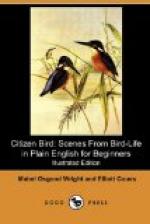“Last year,” said Rap, “when the men were chopping trees in the great wood beyond the lake, the miller went up one day to hunt coons and took me with him. It was the beginning of March and terribly cold; there were long icicles hanging on the trees, and we were glad enough to go in by the fire in the lumbermen’s camp. But what do you think?—if there wasn’t an Owl’s nest, up in a pine tree, with two eggs in it! It was in a very lonely place, and the miller said the Owl had borrowed an old Crow’s nest and fixed it up a little.”
“I should think the eggs would have frozen hard and been spoiled,” said Nat.
“No, the old Owl sat on them ever so tight and would hardly budge to let the miller see them. We didn’t stay long, for the Owl was a savage big thing, nearly two feet high, with yellow eyes and long feathers sticking up on its head like horns.”
“A Great Horned Owl,” said the Doctor. “I only wonder that it let the miller go near it at all; they are generally very wild and fierce.”
“This one was sort of friends with the lumbermen,” continued Rap, “for they used to hang lumps of raw meat on the bushes for it, and they said it kept the rats and mice away from the camp and was good company for them. It frightened me when I heard it first; it gave an awful scream, like a hurt person. After a while another one began to bark like a dog with a cold, just like this—’who-o-o-o—hoo—hoo—hoo.’ And, Doctor, one of the lumbermen told me that with Owls and Hawks the female is mostly bigger than the male. Do you think that is so? Because with singing birds the male is the largest.”
“Among cannibal birds the female is usually the largest,” answered the Doctor, who was pleased to see that Rap so often had a “because” for his questions. “These birds do a great deal of fighting, both in catching their living prey and holding their own against enemies; and as the female stays most at home, being the chief protector of the nest, she needs more strength.”
“Some singing birds are real plucky too,” said Rap. “That same year I found a Robin’s nest in April, when the water-pail by the well froze every night, and a Woodcock’s nest in the brushwood. It’s hard to see a Woodcock on the nest, they look so like dead leaves. It snowed a little that afternoon, and the poor bird’s back was all white, but there she sat. It made me feel so sorry, and I was so afraid she might freeze, that I made a little roof over her of hemlock branches. And she liked that and didn’t move at all; so then I wiped the snow off her back, and she seemed real comfortable. I used to go back every day after that to see her; we grew to be quite friends before the four eggs hatched, and I’ve seen them do queer little tricks; but I never told anybody where she lived, though, because lots of people don’t seem to understand anything about birds but shooting or teasing them.”
“Some day you shall tell us about what the Woodcock did, my lad. You must tell us a great many stories, for you know what you have seen yourself. That is the best knowledge of all, and it will encourage Nat to hear you,” and Dr. Hunter put his arm affectionately around the shoulders of each boy.




